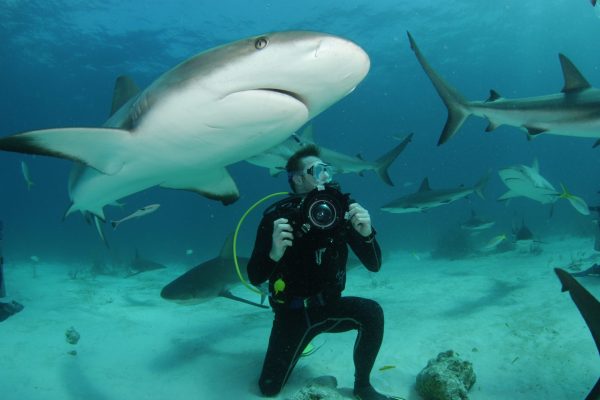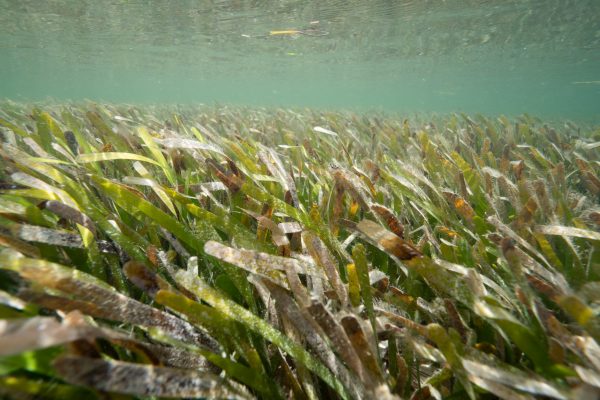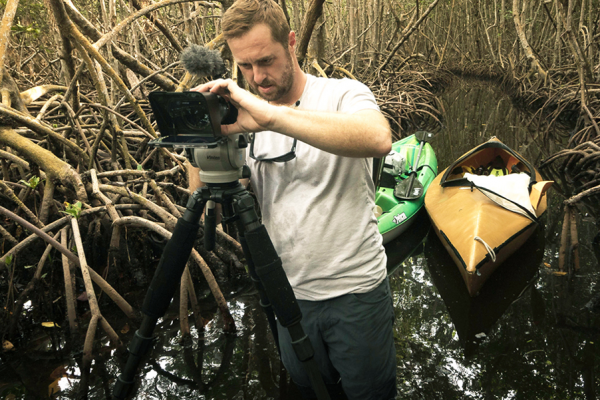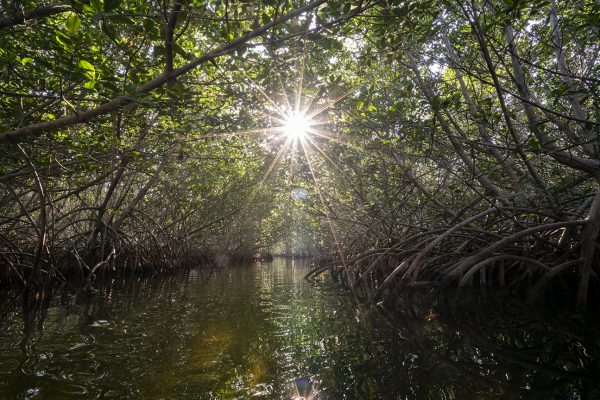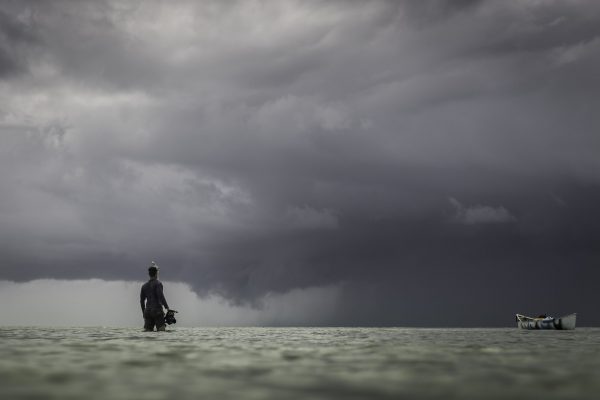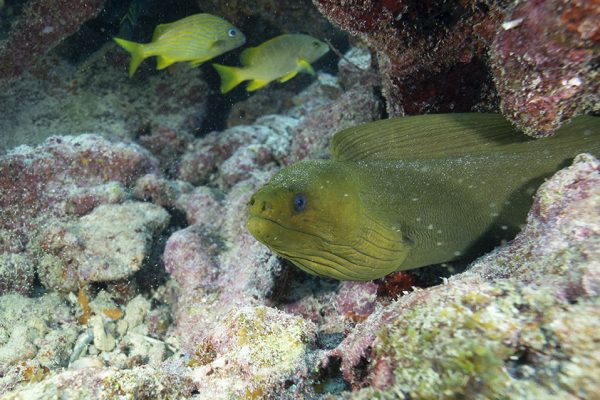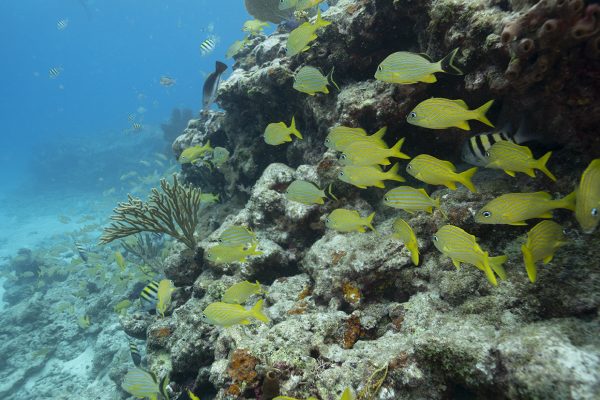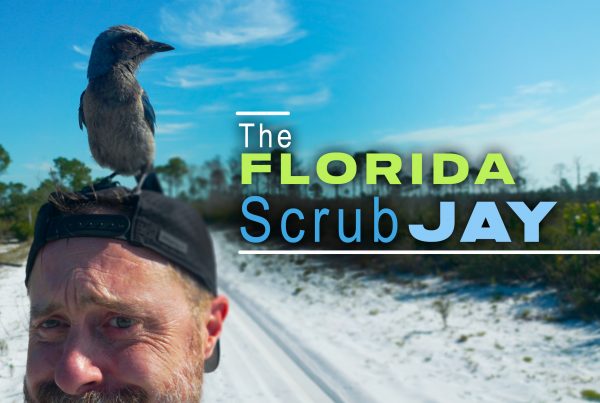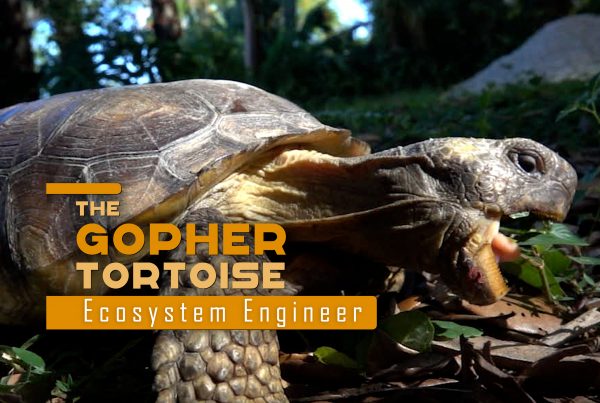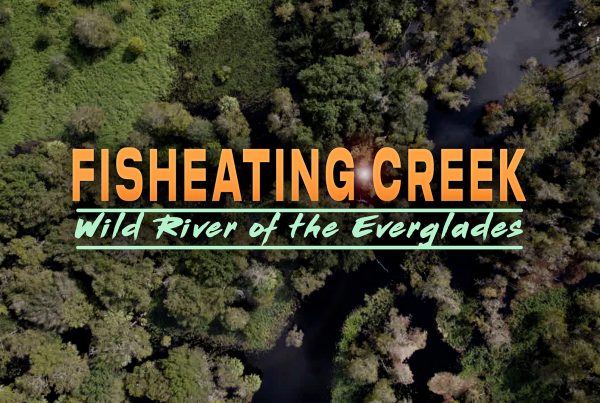Miami is paradise. Here, South Florida dips its finger into the sea and millions travel from all over the world to dive into the warm, coastal waters fed by the rich wetlands of the Everglades.But Biscayne Bay and Florida Bay are in trouble, and we’re the reason why.
Filmmaker Richard Kern explores the transitional estuaries of the Everglades including the coastal mangroves and the vast seagrass beds of Florida Bay. The journey ends with the barrier reefs of South Florida that are, when healthy, bastions of biodiversity. Along the way audiences will chick in on researchers as they catch and tag important marine species and study the links between seagrasses, mangroves and the water issues that threaten the unique habitats of the Greater Everglades bioregion.
You, Me and the Sea: Human Impact and the Coastal Everglades
It’s a sunny Saturday in South Florida and the beaches are packed. If you grew up here like I did, it’s just another weekend. But each year over 12 million tourists pack their swimsuits and head to Miami to bask in the sun and enjoy the turquoise waters of Biscayne Bay. You can’t argue….this is paradise. But the landscape is changing.
In 1920, about 40,000 people called Miami-Dade home. Today, less than 100 years later, over 2.5 million of us live here. That’s 60 times as many people. Our impact on the land is stunning. Our impact on the sea is less obvious, but it might be even more serious.
South Florida is warm year-round, and that’s part of the appeal. But the whole world is getting warmer.
Miami is ground zero for global warming because if it continues, there could be zero ground left. You see if the Earth keeps warming, enormous ice sheets in the Polar Regions will melt completely, adding billions of gallons of water to our oceans. Some scientists estimate that if global warming isn’t slowed, our oceans could rise 5 feet or more in less than 100 years. Most of South Florida will be underwater
Climate change is a huge challenge for our future. But Florida’s coastal waters face other, more immediate problems. In recent years, we’ve seen shocking images: blue-green algae blooms, red-tides and fish kills on the east and west coasts. Massive sea grass die-offs in Florida Bay. Plastic waste and coral bleaching events in Biscayne National Park and the Florida Keys. The news seems dire, and human impact is mostly to blame. But here’s the good news. If we care enough about the health of our coastal environments and work together, we can fix this. So where do we start?
Well, to find out why South Florida’s coastal waters are sick and how we can help, we need to know how the Everglades works. You heard right. Believe it or not, Florida Bay and Biscayne Bay are actually part of the greater Everglades ecosystem.
The Sloughs
During the summer rainy season, the vast sawgrass prairies fill with water and the Everglades become one big wetland. But it isn’t a stagnant swamp….it’s actually a wide, flowing river! The water of the Everglades slowly drifts South-West where it eventually mingles with the more salty water of Florida Bay and Biscayne Bay.
During the winter, however, the Everglades dries up and the remaining water is concentrated in ponds and deeper sloughs. These sloughs are the life-sustaining arteries of the Everglades and this is where our story begins.
In addition to water, the sloughs carry nutrients from the interior to the coast and provide passage for aquatic animals. The downside is they can also transport pollutants. This means that what happens in places like the Everglades agricultural areas could affect the sport-fishing in Florida Bay and beyond.
The two most important sloughs in the Everglades are Taylor Slough and the Shark River Slough. These become super highways for animals like alligators, especially in the dry season. Alligators aren’t the only animals with an appetite. Recreational fishing is big business in the coastal Everglades. This area is famous for hard-hitting sport fish like largemouth bass and snook. Dave Rose and his buddies have been making the trip from the Florida Keys to Flamingo practically every full moon for the past few decades. It’s a long trek down the Shark River, deep into the interior of the Glades. But when you see the sun rise over Coot Bay, you understand why this trip is a monthly tradition.
Dr. Jennifer Rehage and her graduate students fish without bait. They use electricity…shocking isn’t it! They’re studying fish populations in and around the Shark River using a special electro-fishing boat provided by the US Geological Survey. One of the main things Dr. Rehage is trying to understand, is how fish respond to seasonal changes. Where do they go when water levels go up and down, when the salinity of the water changes?
Data collection is the challenging part. But electricity makes things a bit easier…and a lot more fun! While zapping fish with electricity seems like an intense way to gather samples, it’s actually a convenient, non-lethal way to catch these fish long enough to study them. Once they are measured and tagged, they’re released.
Gathering large amounts of data is crucial to scientific research. But this is a huge job for just a few scientists. That’s when Jennifer and her team had a brilliant idea: By partnering with recreational anglers, they can gather a ton more data on the fish that they are studying.
Now, whenever Dave and the Southernmost Bass Anglers fish the Everglades, they make sure and scan each bass and snook they land. Once in a while they catch a fish that has been implanted with one of Dr. Rehage’s PITT tags. They call this a “recapture,” and when they get one, everyone’s excited!
Dr. Rehage’s team benefits from tons of extra data that they couldn’t collect on their own. Their research, in turn, will benefit the anglers. With a better understanding of what affects fish populations and why, we can better understand how to keep the fisheries healthy. It’s a win for the ecosystem and for recreational fishing.
The Mangal
The mangrove forests that fringe the coastal Everglades provide important shelter for birds and sea life. They also provide humans with safety. For one, they combat climate change. Plants store large amounts of carbon safely within their tissues. The more plants we have on this planet, the less carbon there will be in the atmosphere. Carbon dioxide is one of the main drivers of global warming.
The looping prop-roots of the red mangrove are what allow this highly specialized tree to anchor into the sea floor and thrive in this coastal environment. In Florida we have 3 main species: the white the black and the red and the buttonwood is sometimes considered to be a 4th species. But the red mangrove is the most prolific of the mangroves and is hugely important to the ecosystem.
Red mangrove prop-roots stabilize the soils, preventing coastal erosion and they act as a buffer zone that dampens the effects of tropical storms and hurricanes. Once submerged, those roots are as important to marine life as the canopy is to bird life. The tangly structure becomes a trellis for colorful invertebrates to latch on to. Sponges add splashes of color to this shadowy habitat. Groups of anemones decorate the prop-roots, competing with clusters of tunicates for real-estate. Barnacles establish a stubborn foot-hold and spend their days filtering plankton and detritus from the water.
The leaves that are shed by the mangrove form the base of the food web. This “mangrove nursery” is also home to large schools of mangrove snapper and juvenile reef fish. They spend their vulnerable teenage years among the prop-roots where they can dart to safety.
These guys have a bit of growing to do before they can take a large mangrove snapper. But if all goes well, these American Crocodile hatchlings will become the top predators of the mangrove fringe. Biologist Mario Aldecoa is measuring and marking this brand new clutch of baby crocs. These markings and measurements will help him track their development over time. Once he has recorded his data, it’s time to release them.
For these crocs, home happens to be a Nuclear Power Plant!
A nuclear power plant may seem like a weird place to settle in, but for the crocs, it is one of the few places in the area with sandy soils ideal for making nests. With only about 2000 of the endangered species left in Florida, this has become critical habitat. Fortunately, Mario’s efforts seem to be paying off and crocodile numbers are on the rise.
Hatchling crocodiles are vulnerable to all sorts of threats…from egrets to snakes… even land crabs! Mario has a special connection with crocs, but he knows it is always smart to keep an eye out for mama. Hopefully mom’s protective instinct will help these crocs grow to be the kings of the mangrove fringe.
While baby crocodiles are hatching in the coastal everglades, red mangrove trees are giving live birth! ….sort of.
Like humans, the red mangrove is considered to be “viviparous” meaning the embryo develops inside the body. For most plants, the ripened fruit falls to the ground and the outer wall rots away. This disperses the seeds inside, which germinate when they come in contact with the soil. For the red mangrove, the seed actually germinates within the fruit, and the embryo begins to grow while it is still attached to the tree. It will keep growing until it is about 6 or more inches long. Eventually, this propagule, or embryonic red mangrove plant, breaks free from the fruit and falls into the water where it floats along horizontally. Some people call this a sea pencil. What it is is a miniature, pre-packaged mangrove tree!
Now at the mercy of the tides and the waves, the propagule may float for more than a year and wind up far from the parent tree. Eventually it becomes water-logged and spears into the mud. With new roots now firmly planted, a tiny cone of embryonic leaves opens up and the leaves begin to gather sunlight and grow. This has proven to be an incredibly efficient method of propagation and today we can find red mangroves on tropical and subtropical coasts around the globe.
The Estuary
The coastal Everglades which includes the mangrove fringe and seagrass habitats of Florida Bay and Biscayne Bay is a transitional zone called an “estuary.” An estuary is a partly enclosed coastal body of brackish water with one or more rivers or streams flowing into it, and with a free connection to the open sea. “Brackish” simply refers to water that is more salty than fresh water, but not as salty as seawater. “Salinity” is the “saltiness” or dissolved salt content of a body of water.
Traditionally, Biscayne Bay and Florida Bay had a steady input of fresh water from the Everglades, even during the dry season. This created the brackish conditions necessary for a healthy estuary. That changed when humans began draining the River of Grass through a complex network of canals. Today, if we experience a drought, these estuaries can actually become super saline, or “saltier” than the surrounding ocean.
And this is exactly what happened in the summer of 2015. A drought, mixed with super hot temperatures, made the salinity levels in Florida Bay spike, and this is bad news for sea grass
So in 2015 we had the perfect storm. The perfect storm in the sense that we had predominantly south winds all summer long. We had no rain. And without the rain and the natural sheetflow from Lake Okeechobee that we would normally get this side of the Everglades, we had an influx of saltwater in the park. … in 2015 we lost between 40,000 and 50,000 acres of grass in Florida Bay.
In Florida Bay and Biscayne Bay, sea grass is the base of the food chain. If the sea grass collapses, so do the small critters that rely on it for habitat and food. When those primary consumers disappear, so do the animals that eat them.
Wading birds like roseate spoonbills and reddish egrets are very sensitive to changes in their environment. When their foraging habitat is healthy, there are plenty of fish to eat. When there is lots of food, they produce more offspring. This means that wading birds are great “Indicator Species.” An “Indicator Species” is an organism whose presence, abundance or absence is a reflection of the health of the environment in which it lives.
As a top predator, the bottlenose dolphin is also an indicator species. This dolphin has discovered a particularly healthy habitat to prowl, and the tarpon are plentiful. Who says you can’t have some fun with your food?
For recreational fishing guide Benny Blanco, there is a clear connection between healthy seagrass, and one of his most valuable fish: the bonefish.
So bonefishing in the park has changed dramatically over 15 years. … the most obvious change is their range, and the range is directly proportionate to the amount of grass in the habitat that’s available.
Dr. Rehage has also been concerned with the declining bonefish population. One of the big mysteries she is trying to solve is: what habitats are baby bonefish utilizing, and what are their environmental requirements?
We’re pulling nets in places where you would not think there would be bonefish. So it’s been really rewarding. We’re running our nets through these muddy, hot places, very little seagrass, in places in the Everglades where we thought there would be no bonefish and yet, we’re finding bonefish which has been really rewarding.
Finding juveniles of this size is incredibly rare, especially in coastal bays like these. Under natural conditions, these bays would be brackish, with a high input of freshwater flowing from the Everglades. These areas were also hardest hit during the 2015 seagrass die-offs in Florida Bay when freshwater input trickled to a halt during the heat of the summer.
Back in the lab, the team has had another revelation by analyzing, of all things, a small calcium carbonate structure called an “otolith.”
The otolith is the ear-bone of fish. They’re used for balance and for hearing, but they also grow in rings and they are a hard substance. Because they are a hard substance that’s always present in the fish, it provides and it’s absorbing chemical information about the chemical environment that fish experience and they provide a record about the entire chemistry of fish as they grow.
Dr. Rehage has discovered that most of the baby bonefish she has netted, are using low-salinity environments early in their life history. This finding has potential implications for the importance of Everglades restoration. In other words, restoring freshwater flow to the estuaries of Florida Bay might be the right formula for a healthy bonefish nursery.
Seagrass
Seagrasses are the all-important autotrophs, or producers of Florida Bay and Biscayne Bay. Using the sun’s energy they manufacture food energy for countless small animals that find refuge among the dense meadow of seagrass blades. As with the mangrove fringe, this is an important nursery ground for marine species that will graduate to the coral reef habitat or open ocean beyond.
Like the mangroves, seagrasses are flowering plants that are crucial to the health of the ecosystem. Unlike mangroves, they live completely submerged.
They can be found around the Earth in shallow, temperate and relatively clear waters….conditions necessary for capturing lots of light.
It can seem like an alien, bizarre world in the seagrass habitat. Spaghetti worms deploy their tentacles throughout the grass bed to collect food, only to slurp them back into their burrows when harassed. A close look amongst the blades and you might find yourself watching a scallop watching you. The brittle star jerks his way through the landscape, while the starfish glides around smoothly. The starfish enjoys an easy ride, thanks to hundreds of hydraulically-powered tube-feet. It might be slow going, but in timelapse, the starfish really covers some ground.
The lettuce sea slug is weird, beautiful and brilliantly camouflaged to look just like the sea lettuce it eats. Like plants, the green color of this gastropod comes from chloroplasts which are absorbed into its tissue. This allows the animal to gather energy through photosynthesis, hence the nickname “solar powered slug!”
Cassiopia is also fed, in part, by the sun. Like other jellyfish, its tentacles are equipped with stinging cells to subdue small prey. Unlike other jellyfish, cassiopia acts as a host to a special kind of photosynthetic alga that lives within the spoons of its tentacles. The excess nutrients created by the algae are passed on to the jellyfish. Cassiopia will sometimes swim upright like a proper jellyfish. But most often the “upside-down jellyfish, as it is called, is content to rest peacefully on the seafloor. It’s not uncommon to find expanses of upside-down jellyfish basking with their tentacles reaching towards the sun.
The Keys
Forming the South Eastern border of Biscayne Bay and Florida Bay is a strand of islands we call the Florida Keys. The Keys have attracted thousands of people looking for their own slice of paradise. Today, houses and hotels sit on the ancient graveyard of what was once a massive barrier reef. During the Pleistocene epoch when the world’s oceans were much higher, the Florida keys were a thriving submarine habitat. Once-living corals were the architects of the rocky islands that were left behind when the waters receded.
The miniature Key deer has adapted fairly well to the island life…well, for the most part. A subspecies of the white-tailed deer, the Key deer is much smaller than his cousins on the mainland. This miniaturization is the product of thousands of years of isolation and competition for land and resources. Today, approximately 800 Key deer are forced to share a couple of small islands with a growing human population, and unfortunately, their worlds are constantly colliding. Approximately 70% of Key deer deaths are the result of automobile collisions.
The Living Reef
Just past the barrier Key islands is a younger, submerged, living coral reef system. This is the only living barrier reef in the continental U.S., and the third largest in the world.
The barrier reefs of the Florida Keys are not considered to be part of the Everglades ecosystem, but they are highly dependent on the Everglades for survival. As we learned, the mangrove fringe and seagrass beds are nursery grounds for adult reef fish. Seagrasses also filter the water coming from the Everglades and the mainland, removing harmful pollutants and trapping sediment that would cloud the water.
Corals are actually animals and are related to jellyfish and sea anemones. They grow in colonies made up of individual coral animals. We call this single animal a “polyp.” Coral polyps feed on zooplankton that drift by, subduing their prey with microscopic, spring-loaded darts that fire from their tentacles. They also get a large amount of nutrition from a type of alga called zooxanthellae that lives within their tissues.
There are many different varieties of corals like soft corals, which decorate the ocean floor like a submarine garden. But hard corals, like the brain coral, are the architects of the coral reef ecosystem.
As polyps grow they secrete stony cups of calcium carbonate around themselves for protection. This is a piece of coral rock. There are no longer any living polyps, but you can see the structure that those polyps left behind. Over time, a colony of coral polyps will keep reproducing and secreting calcium carbonate to construct a stony structure that becomes a haven for other marine life.
Coral reefs are like the tropical rainforests of the sea. Although they account for only 0.1% of the world’s ocean surface, they are home to 25% of all marine species. A healthy coral reef is exploding with life and in South Florida, this means tourism dollars. Millions of them.
Because of the amazing biodiversity, coral reefs are popular spots for recreational diving. Key Largo has been called the “Dive Capitol of the World” for good reason. Divers are treated to a kaleidoscope of colorful fish, like the queen angel and the squirrel fish. Parrot fish graze on algae, keeping the rock clean where new coral colonies might become established. The parrot fish clips off bits of coral rock too. The waste is excreted as sand. Without parrot fish poop, we wouldn’t have sandy beaches, I’m not even kidding!
The reefs are fringed with sand and rubble, foraging grounds for several marine predators. There’s gotta be a lobster in there somewhere. The spotted goatfish is well suited for this habitat, using a special pair of barbels to probe the sand for a meal. While the goatfish roots around for invertebrates, wrasses hang close to snag any leftovers.
Most species of hard corals shelter their tender polyps from parrotfish and others during the day. At night, many of those fish tuck themselves to bed, so to speak. With the exception of the big-eyed squirrel fish, most are not equipped to see in the darkness. Nighttime on a coral reef is a surreal experience. Stony boulder corals now bristle with thousands of groping polyps. The water itself becomes rich with planktonic prey. Lobsters and crabs roam the seafloor, hopefully staying clear of slumbering nurse sharks. Sea turtles seem fascinated by our lights, as do a pair of iridescent reef squid. The midnight parrotfish, ironically, is much more active around noon. Another day on the reef and the parrotfish are back to their important work. The parrot fish, however, can’t help but nip off a live coral polyp or two. Although they are important, too many parrot fish on a reef could put too much pressure on the live coral. Good thing we have top predators.
Sharks, Predators in Peril
Sharks get a bad rap, but they are essential because they maintain the balance of the coral reef by keeping smaller fish populations in check. If sharks disappear, the whole food web is out of whack.
Sharks are disappearing fast. The culprit: Us. Humans have been pushing sharks to the edge of extinction. Sharkfin soup is a delicacy in China and demand for this dish is what has been driving the slaughter. Approximately 100 million sharks are butchered every year for their fins.
But where sharks are protected, where we find them thriving, we often encounter thriving habitats as well. I had the opportunity to witness this first hand in Cuba’s “Gardens of the Queen,” a remote chain of protected islands and reefs off of Cuba’s southern coast. Here, I shared the reefs with more Caribbean reef sharks and more healthy corals in a week, than over 20 years of diving in South Florida.
The Future
Coral reefs are often called the ‘cities of the sea’. But the buildings are crumbling. Today, many of Florida’s reefs are full of dead or dying coral. Lots of factors are contributing to this: Recreational dive pressure, careless boaters, coral bleaching events and ocean acidification which is the result of too much carbon being absorbed by our oceans.”
Dying reefs are bad news for our fisheries, and our tourism-based economy. Artificial reefs may be one of many solutions. Just as humans need homes, so do many forms of marine life. That’s why coral reefs are so popular. They provide structure for fish to find shelter, and attachment points for invertebrates to anchor onto.
Artificial reefs can take many forms. Ships like the USCGC Duane and the USS Speigel Grove were intentionally sunk and are now havens for both fish, and recreational divers, relieving dive pressure from natural coral reefs elsewhere in the Keys.
The best solution of all, however, would be to figure out how to bring our natural coral reefs back to life. Corals are delicate, sensitive animals, but Ken Nedimyer has developed a method to cultivate branching corals as if he were tending a garden.
Using a chipping hammer, volunteers clear the algae from an area of rock. Next, a ball of epoxy is applied and the new coral is cemented in place. With the right conditions, these transplanted corals will grow and reproduce.
What will this reef look like a year from now, a decade from now? Because of our actions, coral reefs, the estuaries of the Everglades, have suffered. The good news is, we have the power to repair much of what we’ve broken. No one understands this better than Benny Blanco.
So for me a perfect day in Florida Bay is when we have a light Northeast wind, combined with an outgoing tide on the west side of the bay because it lends itself to cleaner water situation. And everyone comes here to sight fish. No one comes here to blind cast in the mud.
I’m fully connected to Florida Bay in the sense that when I was a kid, I found myself here. It’s where I come when I need to reconnect, it’s where I come when I need to get away from the planet, and I’ve been fishing in Florida Bay for 30 years, been guiding for 20, since 1998, and the last 10 years I’ve been full time, 280-300 days a year. So the health of the bay is critical to me personally, emotionally, but it’s also critical to my business and livelihood and how I feed my family.
There’s a great part of me that understands that if we’re ever going to have an existence on this planet as a race, we have to leave places like this better than we found them.

